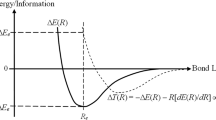Abstract
Within the framework of different approaches (analysis of diabatic potential energy surfaces and analysis of orbital interactions for systems consisting of an attacking reagent and a substrate, chemical applications of density functional theory), the nature and effects of ambivalence in chemical reactivity have been interpreted. In terms of the concepts of dynamic and immanent ambivalence, the interrelations between reactivity, electronic spectra, and electrochemical characteristics of molecules are discussed briefly.
Similar content being viewed by others
Literature cited
H. Fujimoto and K. Fukui, “Intermolecular interactions and chemical reactivity,” in: Chemical Reactivity and Reaction Paths, G. Klopman, ed., Wiley, New York (1974).
S. V. Volovik, N. S. Zefirov, and V. I. Staninets, “Ambivalence (nucleophilic-electrophilic dychotomy) in chemical reactions,” Dokl. Akad. Nauk Ukr. SSR, Ser. B, No. 10, 35–39 (1987).
S. V. Volovik, “The problem of ambivalence in organic reactions,” Teor. Éksp. Khim., 24, No. 3, 274–281 (1988).
S. V. Volovik and V. Staninets, “Ambivalence, reactivity, and regioselectivity in organic reactions,” Ukr. Khim. Zh., 55, No. 9, 992–1066 (1989).
R. G. Parr and R. G. Pearson, “Absolute hardness: Companion parameter to absolute electronegativity,” J. Am. Chem. Soc., 105, No. 26, 7512–7516 (1983).
M. Berkowith and R. G. Parr, “Molecular hardness and softness, local hardness and softness, hardness and softness kernels, and relations among these quantities,” J. Chem. Phys., 88, No. 4, 2554–2557 (1988).
M. V. Basilevsky, “Transition state stabilization energy as a measure of chemical reactivity,” Adv. Chem. Phys., 33, 345–398 (1975).
N. D. Epiotis, W. Cherry, S. Shaik, et al., “Structural theory of organic chemistry,” Top. Curr. Chem., 70, 1–250 (1977).
R. Parr, R. Donnelly, M. Levy, and W. Palke, “Electronegativity: The density functional viewpoint,” J. Chem. Phys., 68, No. 8, 3801–3807 (1978).
R. G. Parr and W. Yang, “Density functional approach to the frontier electron theory of chemical reactivity,” J. Am. Chem. Soc., 106, No. 14, 4049–4050 (1984).
K. Fukui, Theory of Orientation and Stereoselection, Springer, Berlin (1975).
J. Perdew, R. Parr, M. Levy, and J. Balduz, “Density-functional theory for fractional particle number: Derivative discontinuities of the energy,” Phys. Rev. Lett., 49, No. 23, 1691–1694 (1982).
A. R. Orsky and M. A. Whitehead, “Electronegativity in density functional theory: Diatomic bond energies and hardness parameters,” Can. J. Chem., 65, No. 8, 1970–1979 (1987).
Z. Zhou and R. G. Parr, “New measures of aromaticity: Absolute hardness and relative hardness,” J. Am. Chem. Soc., 111, No. 19, 7371–7379 (1989).
S. V. Volovik, V. I. Staninets, and N. S. Zefirov, “Immanent ambivalence of π-electron systems,” Dokl. Akad. Nauk Ukr. SSR, Ser. 8, No. 6, 40–44 (1988).
H. Fukutome, “Spin density wave and charge transfer wave in long conjugated molecules,” Prog. Theor. Phys., 40, No. 5, 998–1009 (1968).
H. Fukutome and M. Sasai, “Theory of electronic structures and lattice distortions in polyacetylene and itinerant Peierls systems. 1. UHF transfer matrix method adapted to the long range Coulomb interaction and UHF states in regular bond alternated lattice,” Prog. Theor. Phys., 67, No. 1, 41–67 (1982).
A. E. Belinskii, A. L. Chugreev, and I. A. Misurkin, “Different types of states of one-dimensional system of electrons in the approximation of the unrestricted Hartree-Fock method,” Teor. Éksp. Khim., 25, No. 5, 513–520 (1989).
S. Dähne, “Struktur prinzipien ungesättigter organischer Verbindungen,” Wiss. Z. Tech. Univ. (Dresden), 29, No. 1, 101–107 (1980).
H. Ichikawa, J. Aihara, and S. Daehne, “On the intrinsic difference between topological aromaticity and so-called quasi-aromaticity,” Bull. Chem. Soc. Jpn., 62, No. 9, 2798–2801 (1989).
R. Hoffmann, A. Imanura, and W. J. Hehre, “Benzynes, dehydroconjugated molecules and the interaction of Orbitals separated by a number of intervening a bonds,” J. Am. Chem. Soc., 90, No. 6, 1499–1509 (1968).
R. F. Nalewajski, “A study of electronegativity equalization,” J. Phys. Chem., 89, No.13, 2831–2837 (1985).
R. F. Nalewajski, “Recursive combination rules for molecular hardness and electronegativity,” J. Phys. Chem., 93, No. 6, 2658–2668 (1989).
Z. Zhou, R. G. Parr, and J. F. Garst, “Absolute hardness as a measure of aromaticity,” Tetrahedron Lett., 29, No. 38, 4843–4846 (1988).
L. N. Markovskii, V. D. Romanenko, and A. V. Ruban, The Chemistry of Alicyclic Compounds of Two-Coordinated Phosphorus [in Russian], Naukova Dumka, Kiev (1988).
I. A. Misurkin and A. A. Ovchinnikov, “Electronic structure and properties of polymeric molecules with conjugated bonds,” Usp. Khim., 46, No. 10, 1835–1870 (1977).
L. G. S. Brooker, “Spectra of dye molecules. Absorption and resonance in dyes,” Rev.Mod. Phys., 14, No. 2/3, 275–293 (1942).
S. V. Volovik, G. G. Dyadyusha, and V. I. Staninets, Regioselectivity and Reactivity of Free Radicals in Processes of Addition and Aromatic Substitution [in Russian], Naukova Dumka, Kiev (1988).
J. Fabian and H. Hartmann, “MO-LCAO calculations of polymethines. 21. Electrono-dative, electrono-captive, and electrono-ambident polymethine radicals,” J. Pract. Chem., 326, No. 3, 443–456 (1984).
R. Huisgen, “1,3-Dipolar cycloadditions — introduction, survey, mechanism,” in: 1,3-Dipolar Cycloaddition Chemistry, Wiley Interscience, New York (1984), Vol. 1, pp. 1–176.
R. A. Moss, “Carbenic reactivity revisited,” Acc. Chem. Res., 22, No. 1, 15–21 (1989).
Author information
Authors and Affiliations
Additional information
Translated from Teoreticheskaya i Éksperimental'naya Khimiya, Vol. 26, No. 4, pp. 413–421, July–August, 1990.
Rights and permissions
About this article
Cite this article
Volovik, S.V., Staninets, V.I. & Zefirov, N.S. Nature of ambivalence effects in chemical reactivity. Theor Exp Chem 26, 390–398 (1991). https://doi.org/10.1007/BF00530251
Received:
Issue Date:
DOI: https://doi.org/10.1007/BF00530251




